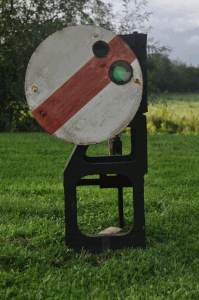

1930s Westinghouse 4 Aspect Colour Light Signal
The restoration was performed with a relatively light touch, as the signal was in a generally good condition.
I partially disassembled the head, removing the external
panels and the mounting casting that is used to attach to the signal pole. The
doors and lens mountings were removed and the two broken glass lenses disposed
of. Internal lamp holders and wiring were left in situ.
The whole unit was then pressure washed both inside and out to remove loose dirt and clean the paintwork. The outer surfaces were polished up with car wax to revive the paint somewhat, but thankfully no repainting on the main castings was needed.
The lens securing rings were heavily rusted so need complete
strip down and repaint.
The sighting boards were cleaned similarly to the main body.
These were painted over galvanised steel and were in generally in sound
condition except round the bolt holes and where the boards overlapped which
were rusty as moisture had become trapped. These areas were treated with rust
preservative.
Internal rusty bolts were treated with rust preventative-
all the remaining rusty bolts and studs were replaced. In some cases this
involved cleaning up threaded holes with a tap.
Once cleaned up, the unit was re-assembled, replacing most
of the removed fasteners with new galvanised ones, along with plenty of grease.
Most fasteners were BSF- a few proved a bit of a challenge to find replacements
for, such as the larger wing nuts, but eventually I found like for like
replacements.
Two of the outer glass lenses were broken, so these were
replaced; one from the stripped ABB signal and another unused one found through
eBay. All the lenses were thoroughly cleaned before fitting.
I replaced the post mount with a gantry base which was stripped and repainted and then bolted to a small wooden frame to prevent it toppling.
The signal came with extended hoods measuring 24" long.
Standard size hoods for the Westinghouse signals was 12" long. These long
hoods were fitted to colour light signals in the late summer of 1940 as the
Battle of Britain raged. As the signals are designed to be viewed from a long
distance, they were accidently a good navigation aid to the Luftwaffe. I
understand that this was such an urgent task that it continued 24 hours a day,
including through air raids. This dates the signal to being in place prior to
the summer of 1940, so now at least 80 years old.
As I have the signal mounted on the ground and using the
original hoods would make visibility difficult, I fabricated new 12"
hoods, using the originals to help make a template.
The hoods were cut from 1.2mm thick steel on my guillotine, holes drilled and corners rounded. They were bent to shape by hand over a length of steel pipe approx. 6" in diameter and then painted.
All the lampholders were cleaned and the wiring checked
over. All was in a generally good condition. The internals were wired for 12V,
so lamps were fitted and the assembly tested.
I have been given some very useful information and help by
the members of the Signal forum in this restoration; Signalbox Forum
I'd particularly like to thank John Webb for his invaluable support. John is a volunteer at the St Albans South Signal Box; St Albans
Nov 2020